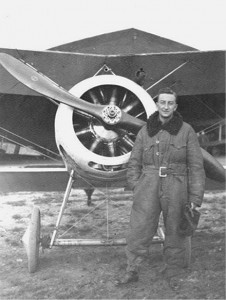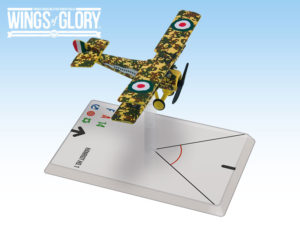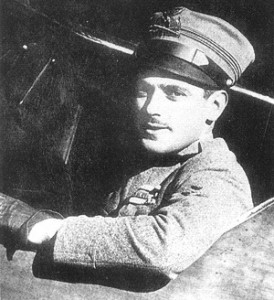The second part of the Hanriot HD.1 preview (click here to see the Part 1) presents the pilots of the three versions of this fighter featured in the WW1 Wings of Glory Airplane Packs: the Belgian ace Willy Coppens, and the Italians, Mario Fucini and Silvio Scaroni.
Willy Coppens
Belgium's leading fighter ace, with 37 victories credited, and the champion "balloon buster" of World War I, Willy Omer François Jean Coppens de Houthulst was born in July, 1892, in Watermael-Boitsfort, near Brussels. He joined the army in 1912 and served with the 2nd Grenadiers before transferring to the Compagnie des Aviateurs in 1915.
He learned to fly at his own expense at a civilian flying school in England, as did other Belgian pilots, and then received additional training in France. In 1916, he began to fly two-seaters in combat. In 1917, assigned to the 9emme unit, he started to fly the single-seat Hanriot HD.1 – he was the first Belgian pilot to use this fighter, and with this, he became an expert at shooting down enemy balloons. From May to October, 1918, he shot down 34 of them, often performing aerial acrobatic displays above the enemy.
On October 14th, in a combat over Torhout, he was severely wounded by an incendiary bullet. Even with the tibia of his left leg smashed and the artery severed, he shot down his target before crash landing. Taken to hospital, he had his leg amputated, ending his career as a fighting ace. He was knighted for his wartime service and decorated by Belgium, France, Britain, Portugal, Italy, Poland, and Serbia.
Despite his disability, Coppens set a parachuting record in 1928, by leaping from 19,700 feet; this record stood for 4 years. He served as a post-war military attaché to France, Britain, Italy and Switzerland. Coppens retired in 1940, and published his war memoirs, “Days on the Wing," in 1931. He died in December, 1986, at 94.
Coppens was also called “Démon Bleu" (Blue Devil) for his cobalt blue Hanriot HD.1. The replica is based on the pilot’s memoirs. He refused to fly with the original mimetic, asking to repaint his aircraft completely in blue. He tried several alternative armaments, and the standard setting of Belgian HD.1s (with the machine gun in the center of the fuselage, instead of the left side configuration, as with the first units delivered by Hanriot) is a result of his trials.
Mario Fucini
The Italian ace Mario Fucini was born in Empoli in February, 1891. He started his military career as a volunteer in the Engineering Corps when World War I began, later transferring to aviation and getting his pilot’s license in March, 1916. Awarded two Silver Medals for Military Valor and one Bronze Medal during the war, he claimed 13 victories, with seven officially confirmed.
At Corpo Aeronautico Militare, Fucini was first assigned to the 5a Squadriglia, flying the bomber and ground attack aircraft, Voisin. He was promoted to lieutenant in March, 1917, and in July, was transferred to a fighter squadron, the 84a Squadriglia. Two months later he was transferred to the 87a Squadriglia, and then to the 76a Squadriglia. By that time, he had started to fly the Hanriot HD.1 and achieve his first victories.
On November 13th, 1917, he downed an enemy two-seater, and by the end of December, he shot down a DFW C.V. He achieved his third confirmed victory in January, 1918, against another two-seater. Transferred to 78a Squadriglia in February, he continued to fly the Hanriot HD.1 and to post victory claims. Four additional victories were officially credited to him from May to October, 1918.
Fucini remained in the air force after the war ended. He retired from active duty in September, 1937, and in April, 1953, he was promoted to General, in the reserves. He published a book with his war memories in 1931, called “Voli sul nemico.” He died in 1977, in Rome.
At 78a Squadriglia, Fucini piloted the Hanriot HD.1 presented in the WW1 Wings of Glory Airplane Pack, with a mimetic applied to the yellowish paint and a long “flame” on the fuselage (similar to many other fighters of the same squadron). On Fucini’s aircraft, the flame was white with a black skull added for any victory he claimed. He asked to mount a second machine gun to his aircraft, after the successful experiences of another Italian ace, Silvio Scaroni.
Silvio Scaroni
With 26 victories confirmed of 30 claimed, Silvio Scaroni is the second-highest scoring Italian air ace of the First World War. Born in Brescia, in May, 1893, he began his military career in the artillery and was transferred to the Italian Air Service in March, 1915, arriving at the 4a Squadriglia as a reconnaissance pilot in September.
He was promoted to first lieutenant and assigned to 43a Squadriglia in January, 1917. During that year he was first reassigned to 86a Squadriglia and then to 76a Squadriglia, as a fighter pilot. In this squadron he started to collect victories. On November 3rd, he claimed its first victory, but it was not confirmed.
However, on November 14th, flying a Nieuport 17, he shot down a two-seater and began his ace scoring. On December 26th, at the battle of Istrana, he scored three victories in the same day. By year's end, he had downed 9 enemy aircraft, 8 of them while flying the Hanriot HD.1.
With the HD.1, Scaroni achieved another 17 victories against fighters, scouts, bombers and balloons. On July 12th, 1918, he was wounded in action after bringing down an Albatros D.III, and the war was over for him. He was awarded with the Gold Medal to the Military Valor, adding to his previous two Silver medals and one Bronze medal.
After the war, Scaroni remained in the air force, commanding the Italian air forces in Sicily during World War II. Scaroni published his wartime memoirs as “Impressions and Memories of Aerial Warfare.” He died in Milan on 16 February, 1977.
The airplane pack presents the Hanriot HD.1 piloted by Scaroni from mid-June 1918 until his last victory. In three weeks, he achieved 9 victories with this machine, identified by Scaroni’s personal ensign – a white square with black edges. Scaroni's experiences led him to update the aircraft with two machine guns (instead of one as it was originally delivered). The same solution was adopted in aircraft piloted by Italian aces such as Flavio Torello Baracchini, Mario Fucini, and Giulio Lega.
Information sources: The Aerodrome, Wikipedia, First World War, “Italian Aces of World War One” - Osprey Publishing, 2009, "Hanriot HD.1/HD.2" - Gregory Alegi, Windsock Datafile n. 92, March 2002.












